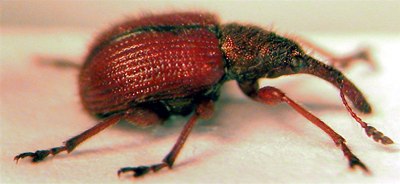Pests
Coenorrhinus aequatus L. - Apple Fruit Rhynchites.
Systematic position.
Class Insecta, Order Coleoptera, Family Rhynchitidae, Tatianaerhynchites Legalov.Synonym.
Tatianaerhynchites aequatus L.Biological group.
It is a pest of fruit crops.Morphology and biology.
The body length is 2.5-5 mm. The rostrum of male is as long as its pronotum and head combined and the rostrum of female is somewhat longer. Antennae is inserted in the middle of rostrum. Scutellum is small, triangular, covered with hairs. First stria of elytra shortened. The head and pronotum are bronzed; rostrum, elytra and legs reddish-brown; elytra suture darkened. Adults feed on buds, flowers, leaves and fruits of apple and some stone-fruit species, especially on hawthorn. Female lays eggs into fruit of apple and hawthorn about one week after blossoming. Optimum air temperature for oviposition is near 16-20°C, and optimum humidity is 60%. Oviposition lasts about one month, peaking in the first half of June. After oviposition the female gnaws fruit stem and the fruit dries up. Eggs develop in 12 days. Larvae development occurs inside dry fruits. In autumn the larvae bury themselves in the soil and make cradles there. Pupation occurs in one year, by the next autumn. Young beetles emerge in autumn, but adults stay inside cradles until the next spring.Distribution.
Inhabits most of Europe including Great Britain; Turkey, the Middle East, and Iran. In the former USSR it is widely distributed throughout the Baltic states, Moldavia, Ukraine, the European part of Russia to Yaroslavl' and Samara Regions eastward, in the Caucasus, West Kazakhstan, and Turkmenistan.Ecology.
The development of one generation lasts 2 years. The majority of over-wintering beetles emerge at the end of April and the beginning of May, 3-5 days before the blossoming of apple. As a pest, T. aequatus replaces Rhynchites bacchus L. in the northern regions.Economic significance.
The species has minor economic significance. This is a pest of plum, cherry, apricot, apple, rarely of pear. Injured fruits of apple usually don't decompose, hanging on the tree for a long time, keeping color, then growing brown and becoming mummified.Reference citations:
Kryzhanovskii O.L., ed. 1974. Pest insects and mites of agricultural plants. V. 2. Leningrad: Nauka. 335 p. (In Russian)Legalov A.A. 2003. Taxonomy, classification and phylogeny of the leaf-rolling weevils (Coleoptera: Rhynchitidae, Attelabidae) of the world fauna. Novosibirsk: http://attelabidae.narod.ru/System_of_rhynchitidae.htm (In English, In Russian)
Savkovskii P.P. 1976. Atlas of the pests of fruit and berry plants. Kiev: Urozhai. 207 p. (In Russian)
Ter-Minasyan M.E. 1950. Roller-weevils (Attelabidae). Fauna of the USSR. Insecta-Coleoptera, 27(2). Moscow-Leningrad: AN SSSR. 231 p. (In Russian)
Vasil'ev V.P. 1955. Pests of orchards. Kiev: AN Ukr. SSR. 265 p. (In Russian)
Vasil'ev V.P., Lifshits I.Z. 1984. Pests of orchard plants. Moscow: Kolos. 399 p. (In Russian)
Zayanchkauskas P.A. 1984. Insects injuring orchards in Lithuanian SSR. New and rare species of insects from Lithuanian SSR. Vil'nius. 62-88 p. (In Russian)


